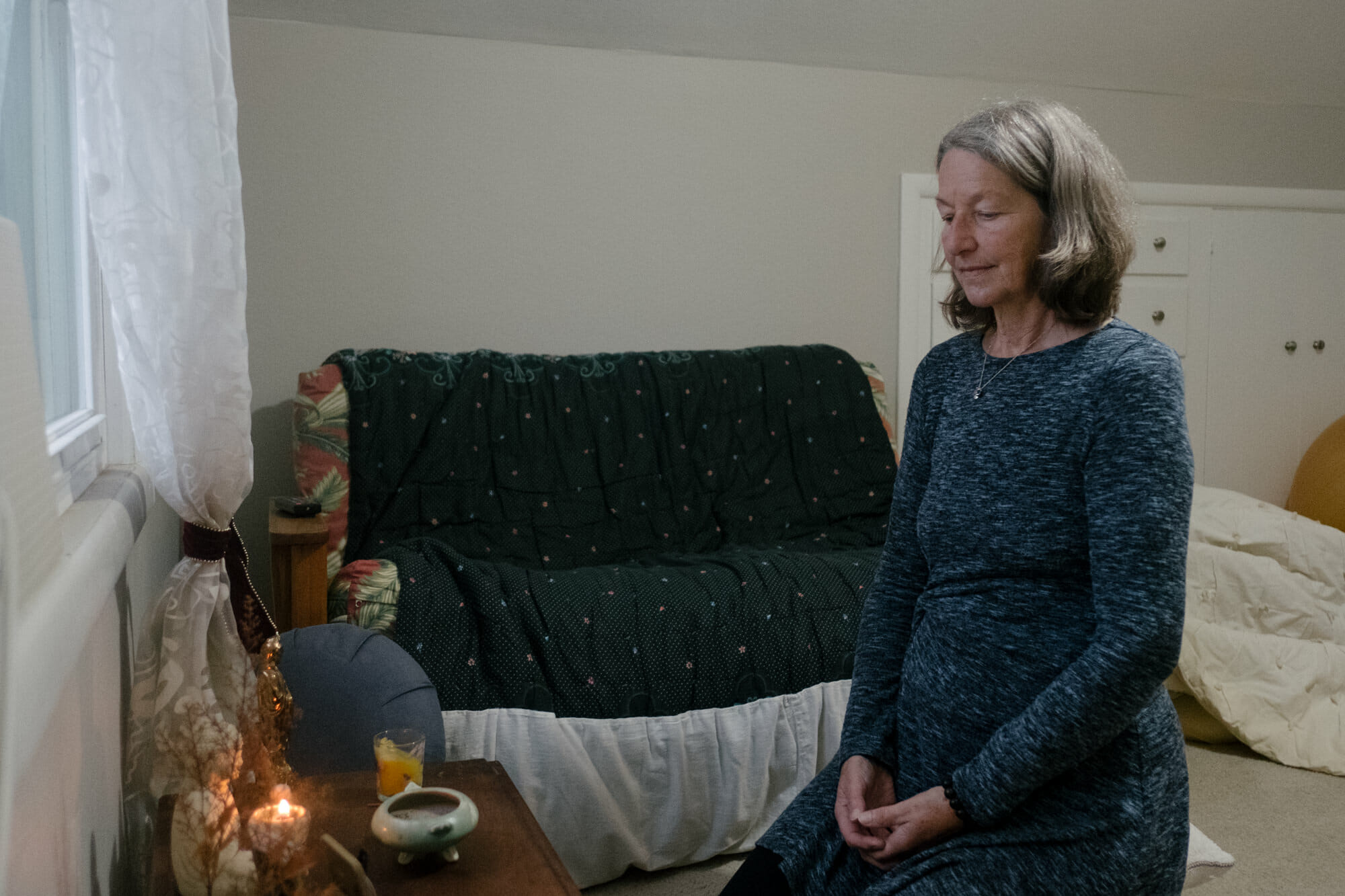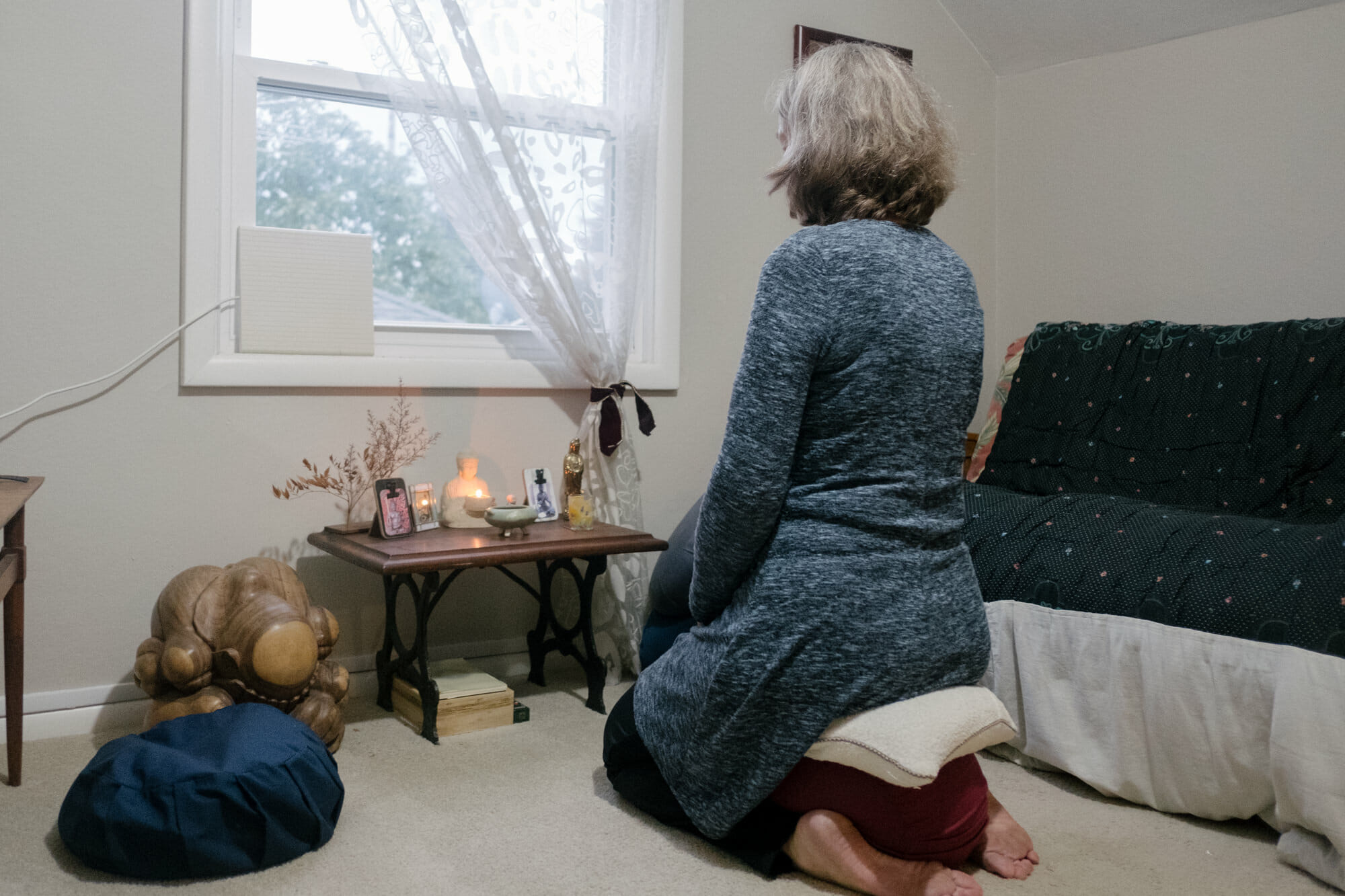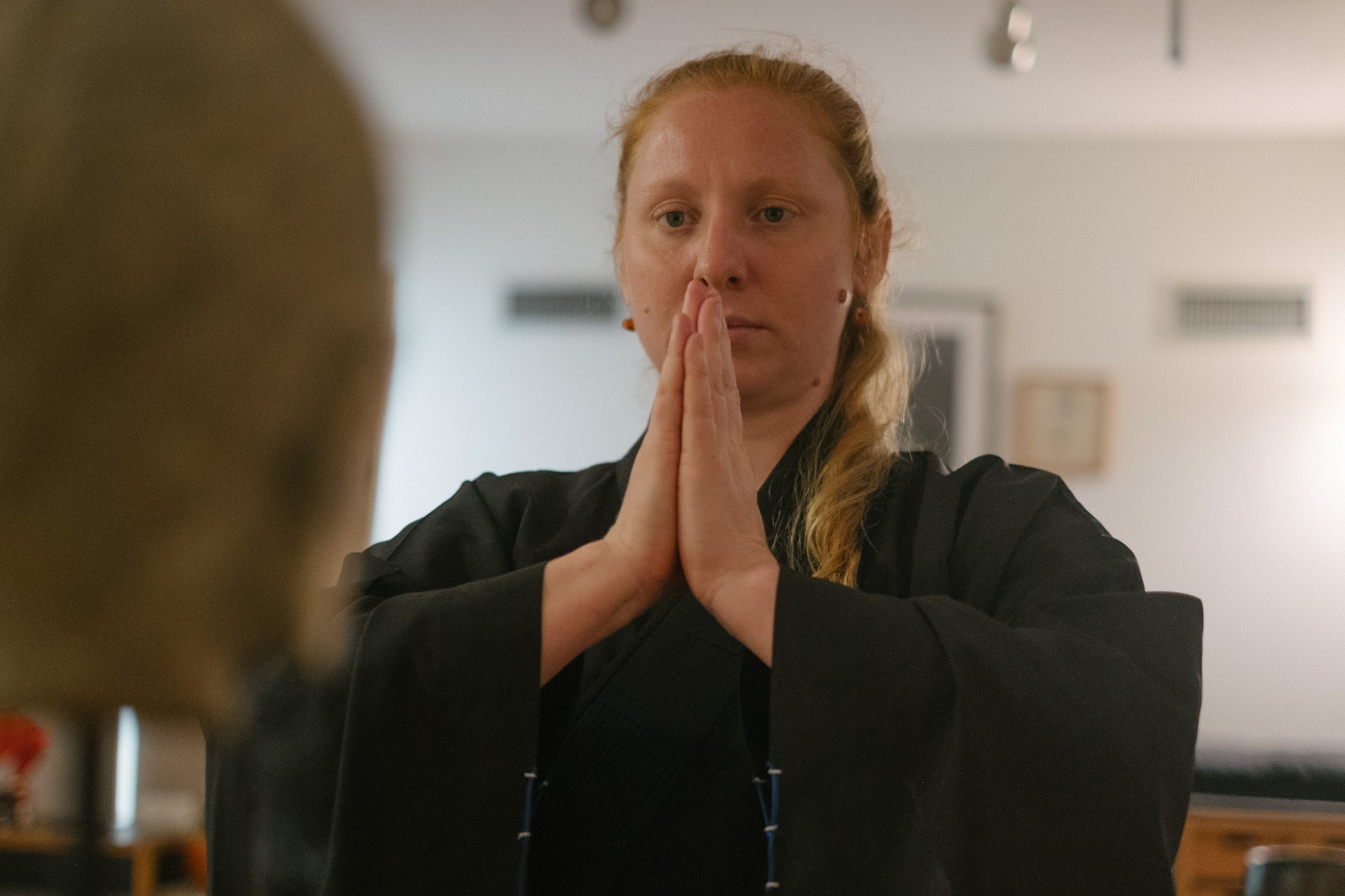When were you first exposed to dharma?
In the fall of 2004, a friend asked me to attend with him and I did. The first time I went, I knew I would return. Not sure I would call that experience knowing this was the path for me; what I knew at that point was that being able to stop talking, to be away from being an “expert” (I practiced employment law – was the sole employment law expertise in the business department of my firm.), needing to know what to do, needing to get it “right”, etc.
How has the path manifest in your daily experience?
Overall, influences/determines how I want to be in the world and with others. I retired from law practice at the end of 2015. Over the course of my 35 years practicing law, I moved away from litigation (largely preceded meeting Buddhist practice, but related to how people relate to each other and wanting to be in the world in a kinder, more wholesome way – accelerated into emphasis on proactive (eventually only proactive) advising and focusing on/learning more about how we communicate, on how to function in organizations, on workplace bullying (including taking Laura Crawshaw’s boss whispering training), on the experience of people transitioning during employment, etc. and relationships In January 2015, Michael (Sojin) Kip and I married. (At Heart of Wisdom, we were the first wedding in the zendo after our community purchased and upgraded/restored the property.) We met in this community and there are so many benefits to sharing this spiritual practice.
What are some of your practices/rituals that you do to support your spiritual development (meditation/prayers and etc)
Meditation, of course. At HOWZT on Thursday evenings, Sunday mornings, and evenings; Meditation is also my ‘go to’ if thinking about things I need to do/anxiety are keeping me awake at night. Loving-Kindness meditation – less regularly at HOW; I shuso when Nan leads it and fill in to lead it occasionally when the regulars (Nan and Kodo) are not available; particularly after working through Christina Feldman’s book, Boundless Heart, in a Meditation & Dharma Drop In I facilitate on Sunday evenings, I find this type of meditation becoming something I go to on a more frequent basis during my days. Meditation twice a week via FaceTime with Kip’s cousin (usually I offer some guidance). The Work of Byron Katie – which I met through this community; after attending her 9-day school, I now do the work on a regular basis with two friends I made there; this year I attended a 3-Day Camp for The Work of Byron Katie and look forward to continuing this involvement in whatever format/event/location works. YouTubes – Hogen, Chozen, Kisei, Jogen, and others from Great Vow Zen Monastery.
Sesshin – twice a year is my current intention (and practice).
Which sangha do you normally attend ?
Wisdom Zen Temple, in-the-city location of the Zen Community of Oregon (ZCO) which also has Great Vow Zen Monastery, a training monastery. Initially provided the structure of weekly sitting for an hour + dharma talks. Has since expanded such that I offer back support in the form of Thursday Head of Zendo responsibilities, facilitating Sunday evening Meditation & Dharma Drop In (45 min program), offer a Work and Zen workshop one Saturday each year and a 3-hour workshop for working and professional woman a couple times each year. I am one of 3 co-facilitators of our six month Awakening to Whiteness program, carrying forward what was initiated, developed and first offered/facilitated by another member of the sangha. I have also held most (and trained in all) service positions so am able to fill in as needed on these. Within the past year, have become involved in the Engaged Buddhism Committee.
What is your primarily profession?
Retired. Previously practiced law for 35 years.
Do you think your personality or background influence the lineage/practices that resonate with you?
Absolutely! As I mentioned above, my childhood religious experiences felt disconnected from the rest of life in a way that caused me to be very resistant to participating if this practice felt separate from the rest of my life. As I began to meditate, go to beginners mind weekends and workshops, then stepped into sesshin (longer retreats) and sanzen (one on one meetings with teacher), my early sense that I was getting what I needed/wanted (not sure of word I want, if feels more like I don’t often know what I need! Yet what I get support and benefits me being better, more aware, more discerning, wiser in the world). One thing specific to my experience is an early childhood in which I was consistently receiving anger and being told I did not belong, was not wanted, was stupid; my experiences in this community are very much to the opposite – and push me to see more clearly what are habits and influences of my past versus what is real and needs attention in the present.
Can you share any powerful experiences (whether it was through mediation or transmissions) and how you integrate/motivate you in your practice?
Many powerful experiences, particularly in the early years of my practice. Motivation was to see what they were, what was going on. (Practically speaking, had I stepped into talking with teachers about them when I was experiencing them, I might – or might not, who knows! – have moved in my life and ways of being more quickly.)
Background
Linda, who encountered Buddhism in 2004, initially drifted through various spiritual paths after abandoning her Catholic upbringing. Despite distancing herself from organized religion early on, she lacked a concrete spiritual practice. However, her perspective shifted when she started dating someone who had spent time at the Great Falls Monastery. Encouraged to attend a Thursday night meditation session in Portland, Linda reluctantly went, expecting it to be similar to the formal Catholic rituals of her past.
With a somewhat resistant attitude, she discovered that the experience was liberating. The hour of silence on the meditation cushion provided a welcome break from her busy life and the constant demands of her role as an employment law specialist. As an introvert, the opportunity to be in silence without the need for conversation was particularly appealing. Despite her initial skepticism, Linda found solace in the practice and has maintained a consistent attendance at Thursday night meditations since the fall of 2004. This routine has become a stable and continuous aspect of her life, offering her a powerful source of relief and tranquility.
Meditation
Linda, who has been involved in meditation instruction for newcomers to the temple for a couple of years, emphasizes the common misconception that meditation is about forcing a desired outcome. She guides individuals away from the notion of making their minds calm through sheer willpower and helps them find physical comfort during meditation. Linda acknowledges the challenge of sitting cross-legged on the floor for extended periods, encouraging alternative postures or the use of supportive cushions.
As an instructor, she not only addresses physical comfort but also delves into the activity of meditation itself. Linda emphasizes the importance of going beyond simple breath-focused instructions, encouraging practitioners to notice the subtle movements of their bodies. She shares her personal favorite technique of observing the expansion and contraction of the body during inhalation and exhalation.
Reflecting on her own experiences, Linda describes how meditation has become a practical tool for calming her mind, even in the middle of the night. She recounts the calming effect of redirecting her attention to the sensations in her body and the changing patterns behind her closed eyes. Linda’s meditation practice has spanned 15 years, influencing various aspects of her life.
She draws connections between her meditation practice and her cycling discipline, explaining how meditation helped her shift from a competitive mindset in cycling to finding joy and contentment in the simple act of being on her bicycle. Linda describes how her perspective transformed from focusing on achieving specific cycling milestones to appreciating the present moment, whether it be the warmth of the sun or the joy of being outdoors. Overall, Linda’s meditation practice has had a profound impact on her life, fostering a sense of mindfulness and contentment in various aspects, especially in her cycling pursuits.
Deepening
Linda, inspired by the teachings of Hogan, a prominent teacher in her Buddhist community, embarked on her meditation journey with a simple yet profound mantra: “Just keep showing up.” Despite her initial reluctance towards the communal aspects of the practice, Linda consistently attended Thursday night sessions, focusing on meditation and Dharma talks. Unintentionally, she found herself taking on a role as a greeter in the community.
Linda’s meditation practice, initially devoid of elaborate narratives or formal meetings with teachers, began to subtly influence her life. Simultaneously, her law practice transitioned towards advisory work, away from litigation. The shift in Linda’s demeanor became apparent when a client remarked on her newfound calmness, a change she hadn’t consciously acknowledged until then.
A pivotal moment for Linda occurred when she took the five precepts, the first public commitment in Buddhism. These ethical guidelines, akin to commandments, resonated deeply with her, especially the positive statements emphasizing the challenge of living ethically rather than focusing on punitive measures for any lapses.
As Linda delved into the SongArc High study program, her curiosity and commitment to Buddhist principles deepened. The program, spanning multiple quarters, allowed her to actively study and present various aspects of Buddhism. Over the last couple of years, Linda’s meditation practice evolved from a strong foundational piece to a source of profound curiosity and drawn-out exploration of Buddhist teachings, marking a transformative period in her spiritual journey.
Challenges
Reflecting on the evolution of her meditation practice, Linda identifies the initial challenge of finding time for it. Starting with short sessions, she set a five-minute timer on her microwave, focusing on her breath while seated near a sliding glass door that connected her to the outdoors. Despite the modest duration, Linda experienced a profound impact, realizing the importance of stopping the practice while it remained enjoyable.
As her commitment to meditation deepened, Linda explored intensive meditation retreats, initially struggling to meet the recommended frequency. However, during a retreat, she relinquished the need to constantly check the schedule, relying on the sound of bells to guide her activities. This experience allowed her to embrace the possibility of living in the present without constant planning.
Linda also shares a transformative period during Thursday night sessions when she consciously balanced energy expenditure in her practice. Greeting attendees and sitting for a full hour without taking a break, she then drove home feeling mentally refreshed despite physical tiredness. This paradoxical experience showcased the transformative power of her meditation practice, marking a profoundly impactful period in her life.
Other Practices
In a practical example of the power of her meditation practice, Linda navigates the challenges of her law firm’s business department during the 2008 economic downturn. Faced with a distressed client and a visibly stressed colleague, Linda employs mindfulness practices during her daily commute. Reciting loving-kindness mantras and utilizing a guided meditation for difficulties, she manages her own anxiety and scattered thoughts, creating a more centered mindset.
Linda’s intentional practices contribute to a positive shift during a crucial meeting, where she aids in reducing stress and improving planning for the client’s situation. Her primary gratitude lies in witnessing her colleague’s relief from distress during the meeting. This experience highlights the pragmatic benefits of meditation in real-world, high-pressure scenarios.
Currently preparing for Ango, a six-week intensive practice period, Linda focuses on cultivating sympathetic joy. She explores whether she views the world through a lens of scarcity or abundance, recognizing her habitual tendency towards scarcity. Linda plans to address this habit through moment-to-moment awareness, acknowledging the abundance in her life and challenging the ingrained perception of scarcity. Her reflections reveal the ongoing transformative impact of Buddhist practices on her daily engagement and appreciation of life.
Relationships
Buddhist practices have profoundly influenced Linda’s relationship with her mother, who lived in Iowa until her passing. Through meditation and loving-kindness practices, Linda realized that the challenges were not about her mother but rather about the part of herself still influenced by her mother’s beliefs. This realization marked a significant point in her Buddhist practice, leading her to understand that the work involved not only herself but also her mother’s karmic journey.
Linda holds a deep vow not to perpetuate anger in the world, which, through her Buddhist practice, has led to a reweaving of temporal aspects, both forward and backward. The practice has softened the impact of her father’s and mother’s anger, alcoholism, and the associated pain, not just for herself but potentially for her family as well.
In her marriage, Linda and her husband share a spiritual connection within the same sangha, offering a unique language and framework for communication. They support each other’s spiritual growth, and Linda appreciates how her husband sees her through the lens of the Buddhist practice, acknowledging her in ways she might not describe herself. This shared value in spiritual life brings a sweetness to their relationship, allowing more space for each other’s individuality and navigating life’s challenges with flexibility and ease. Linda recognizes the good fortune of sharing this practice, fostering a deeper connection and understanding in their relationship.
Teacher
Over the course of approximately ten years, Linda has been engaging in one-on-one sessions with Hogan, her teacher. Describing her experiences is challenging as her Zen practice doesn’t neatly fit into a structured and organized framework. Despite her initial difficulty articulating the essence of these sessions, Linda expresses deep trust in Hogan’s wisdom and spiritual guidance.
The one-on-one interactions with Hogan hold immense value for Linda, and she recognizes the difficulty in finding precise words to convey the depth of this wisdom. She highlights the challenge in translating the teachings into the rational, lawyer-like memory but emphasizes the significance of these meetings in her spiritual journey.
In recent years, Linda’s appreciation for lineage has deepened. She now sees the common thread that unites her individual experience with the core wisdom shared across different practitioners and lineages. This shared essence, discovered through slowing down and allowing the universal to manifest, has become a precious and beautiful aspect of her practice. Linda acknowledges the challenge of expressing the ineffable nature of this shared experience but underscores its realness and the positive, loving, and caring presence that remains constant amidst the human challenges that arise.















































































